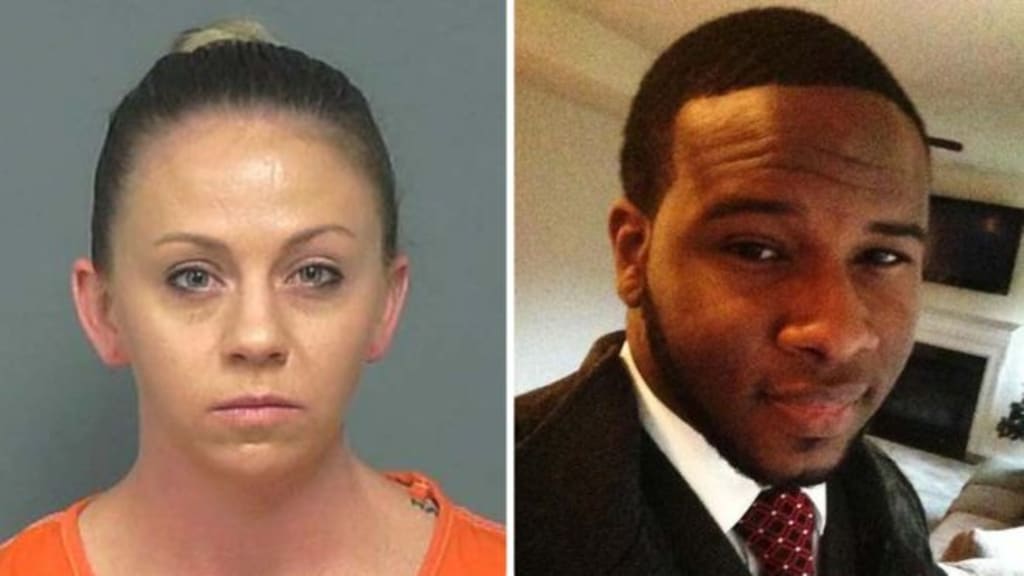What Caused Amber Guyger's Conviction?
What caused Amber Guyger's conviction - and what made her conviction so rare? What does this mean for the future of similar cases?

It’s easy to understand our current situation. In the United States, African Americans are three times more likely to be killed by police officers than white people (Mapping Police Violence). Additionally, said offending officers are rarely indicted—and when they are, their sentences are less than favorable. Out of 98 non-federal law enforcement officer arrests, only 35 had been convicted of a crime involving fatal, on-duty shootings since 2005. (Ross, para. 8). The case of Amber Guyger, however, proves to be an exception.
On September 6, 2018, Amber Guyger (an off-duty Dallas police officer) entered an apartment that she presumed was hers. Upon seeing the apartment’s resident, Botham Jean, she quickly fired her gun, thinking he was an intruder, murdering him almost instantly. She was immediately charged with manslaughter, then released on bond and was put on administrative leave. It wasn’t until the end of November that she was indicted for murder, and it wouldn’t be until October of 2019 that she receives a 10 year sentence for the murder of Botham Jean.
Believe it or not, the first case in which a police officer was convicted for the murder of a civilian in Dallas wasn’t until 2016, when former Farmers Branch police officer Ken Johnson was charged for the murder of Jose Cruz, age 16. “Like Guyger, Johnson was off-duty at the time of the shooting.” (Grant, para. 5) Therefore, it is no surprise that Guyger is only the third officer to be convicted for murder by Dallas juries in more than fourty years. (Grant, para. 6) The burning question is: Why is Amber’s conviction so unique? What was the overall influence for her rare conviction?
A massive element in Amber’s conviction is social media. The event, like many others, spread across Facebook and Twitter like wildfire. The hearings were live-streamed on YouTube and Facebook, enabling viewers to chat amongst themselves, broadcasting their opinions across the globe. Amber Guyger was trending on Twitter multiple times during her eight day trial (Garcia, para. 2), proving that people were passionate about the outcome of the case. Additionally, hundreds if not thousands of news outlets picked up on the story, allowing for detailed accounts and testimonies to be shared all throughout the web—and sometimes, biased accounts of the event. “When Botham Jean was murdered in his own home, we never saw pictures of his family. Instead, we got news that a bag of marijuana was found.” (Batholomew, pg. 8, para. 1) This shred of evidence sent almost every mainstream news outlet rolling—mostly posting “click-bait” articles mentioning that Botham’s lawyer, Ben Crump, claimed that the police were trying to slander Botham’s name. This alone proves that even mainstream media was hoping for the best possible outcome of this case—even if they used biased language and conniving tactics, such as “click-bait,” to do so. Social media brought this case to the eyes of many and opened the floodgates for people who may not have been aware of the police brutality of African Americans in this country. Thanks to this exposure, many saw the potential outcome of the case as a step forward in the right direction toward social justice for the murdering of unarmed black men in America—thus, influencing the jury and others to convict Amber Guyger; almost as an example to prove that we, as Texans and Americans, are acutely aware of the situation and want to remedy it.
There is also relevance among the people who worked on the case during Guyger’s trial/hearing. The case itself must’ve struck a chord with Judge Tammy Kemp, being a black woman of color. She is likely acutely aware of the violence against unarmed black men in this country—as well as the jury. The jury for the hearing consisted of 12 members; only four of them being white. Therefore, it is entirely plausible that the jury was sympathetic to Botham’s family’s plight. Lastly, the lawyer representing Botham/Botham’s family, Ben Crump, who is also African American, even represented the families of Trayvon Martin, Mike Brown, and Tamir Rice (Bellware, para. 8)—strengthening the argument that, yes, the people involved with the case were most likely heavily aware and sympathetic of the racial motivation for the case, and felt more inclined to sentence Guyger fairly.
There’s also something to be said about Dallas specifically. According to the most recent population data available, African Americans make up 25% of the cities population (Dallas, Texas Population 2019). That may not seem like a huge number, or even relevant—however, Texas’ overall population for African Americans is only 11% (Kolmar, para. 2)—meaning the population is more concentrated in Dallas. Due to this concentration, Guyger’s case struck a chord among locals, some of whom even went so far as to rally and protest after she was sentenced—claiming that her sentence of 10 years was too lenient. This kind of pressure and eventual backlash from Dallas locals was a pivotal role in why Guyger was even convicted in the first place, as I’m sure the last thing Dallas officials wanted/needed was some kind of controversy revolving around their police force.
Amber Guyger’s conviction was truly a rare one, especially for Texas. We have social media, diversity, and Dallas itself to thank for that. While her sentence is seen as too little, too late for many, it’s a huge stepping stone for our justice system and the privilege that comes with it.
Works Cited
Bartholomew, Trey. “White Lies on White Paper: The Manipulation Through Media Bias.” 3rd of April, 2019, https://papers.ssrn.com/sol3/papers.cfm?abstract_id=3365038
Bellware, Kim. “Amber Guyger conviction: What we know - and don’t know - about how diverse juries behave.” The Washington Post. 4th of October, 2019, https://www.washingtonpost.com/nation/2019/10/04/amber-guyger-conviction-what-we-know-dont-know-about-how-diverse-juries-behave/
“Dallas, Texas Population 2019.” World Population Review. http://worldpopulationreview.com/us-cities/dallas-population/
Garcia, Nic. “Amber Guyger guilty verdict reverberated on social media.” The Dallas Morning News. 1st of October, 2019, https://www.dallasnews.com/news/2019/10/01/amber-guyger-guilty-verdictreverberated-social-media/
Grant, Melissa Gira. “Not Even the Police Union Could Save Amber Guyger.” The New Republic. 3rd of October, 2019, https://newrepublic.com/article/155239/not-even-police-union-save-amber-guyger
Kolmar, Chris. “These Are The 10 Texas Cities With The Largest Black Population For 2019”. RoadSnacks. 9th of December, 2018, https://www.roadsnacks.net/most-african-american-cities-in-texas/
“Police killed 1,164 people in 2018.” Mapping Police Violence. 15th of May, 2019, https://mappingpoliceviolence.org/
Ross, Janell. “Police officers convicted for fatal shooting are the exception, not the rule.” NBC News. 13th of March, 2019, https://www.nbcnews.com/news/nbcblk/police-officers-convicted-fatal-shootings-are-exception-not-rule-n982741
About the Creator
Jasmine Smoot-Leyva
I’m a professional photographer, filmmaker, musician, podcaster, and author based in Dallas, TX. I'm obsessed with tattoos, my two huskies, and being my own person.






Comments
There are no comments for this story
Be the first to respond and start the conversation.